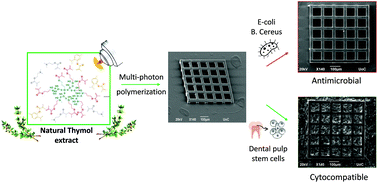Multi-photon polymerization of bio-inspired, thymol-functionalized hybrid materials with biocompatible and antimicrobial activity†
Abstract
Multi-functional materials are of paramount importance in biomedical engineering. In this work, we present the synthesis of a hybrid, organic–inorganic material functionalized with covalently-attached natural antimicrobial moeties based on thymol, an essential oil found in thyme. The hybrid material is a double organic–inorganic network formed by sol–gel chemistry followed by photopolymerizaton of the organic moeities, and allows the fabrication of highly accurate 3D scaffolds by means of multi-photon polymerization. The cytocompatibility of the materials and scaffolds was proved by the excellent cell adhesion and proliferation of dental pulp stem cells, whereas their osteogenic potential was evidenced by the significant production of calcium in the matrix, following functionalization with bone morphogenetic protein-2. The antimicrobial activity of the thymol-functionalized 3D scaffolds against E. coli and B. cereus was demonstrated by the inhibition of bacterial growth after 1 and 4 days in culture. These dual-functional, hybrid materials, exhibiting simultaneously biocompatibility and osteogenic potential, as well as an effective antimicrobial activity are excellent candidates for bone tisue engineering.



 Please wait while we load your content...
Please wait while we load your content...